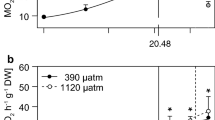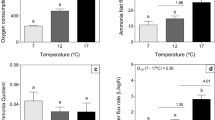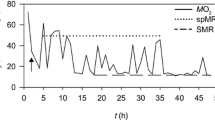Abstract
Hyperventilation is a common response in fish exposed to elevated water CO2. It is believed to lessen the respiratory acidosis associated with hypercapnia by lowering arterial PCO2, but the contribution of hyperventilation to blood acid–base compensation has yet to be quantified. Hyperventilation may also increase the flux of irons across the gill epithelium and the cost of osmoregulation, owing to the osmo-respiratory compromise. Therefore, hypercapnia exposed fish may increase standard metabolic rate (SMR) leaving less energy for physiological functions such as foraging, migration, growth and reproduction. Here we show that gill ventilation, blood PCO2 and total blood [CO2] increased in red drum (Sciaenops ocellatus) exposed to 1000 and 5000 µatm water CO2, and that blood PCO2 and total blood [CO2] decrease in fish during hypoxia induced hyperventilation. Based on these results we estimate the ventilatory contributions to total acid–base compensation in 1000 and 5000 µatm water CO2. We find that S. ocellatus only utilize a portion of its ventilatory capacity to reduce the acid–base disturbance in 1000 µatm water CO2. SMR was unaffected by both salinity and hypercapnia exposure indicating that the cost of osmoregulation is small relative to SMR, and that the lack of increased ventilation in 1000 µatm water CO2 despite the capacity to do so is not due to an energetic tradeoff between acid–base balance and osmoregulation. Therefore, while ocean acidification may impact ventilatory parameters, there will be little impact on the overall energy budget of S. ocellatus.





Similar content being viewed by others
References
Barnola JM, Raynaud D, Korotkevich YS, Lorius C (1987) Vostok ice core provides 160,000-year record of atmospheric CO2. Nature 329:408–414
Boutilier RG, Heming TA, Iwama GK (1984) Physiochemical parameters for use in fish respiratory physiology. In: Hoar WS, Randall DJ (eds) Fish physiology. Academic Press, New York, pp 403–430
Brauner CJ, Wang T, Wang Y, Richards JG, Gonzalez RJ, Bernier NJ, Xi W, Patrick M, Val AL (2004) Limited extracellular but complete intracellular acid–base regulation during short-term environmental hypercapnia in the armoured catfish, Liposarcus pardalis. J Exp Biol 207:3381–3390
Burleson ML, Smatresk NJ (2000) Branchial chemoreceptors mediate ventilatory responses to hypercapnic acidosis in channel catfish. Comp Biochem Phys A 125:403–414
Cahill AE, Aiello-Lammens ME, Fisher-Reid MC, Hua X, Karanewsky CJ, Ryu HY, Sbeglia GC, Spagnolo F, Waldron JB, Warsi O, Wiens JJ (2013) How does climate change cause extinction? Proc R Soc B 280:20121890
Caldeira K, Wickett ME (2003) Oceanography: anthropogenic carbon and ocean pH. Nature 425:365
Cameron JN, Randall DJ (1972) The effect of increased ambient CO2 on arterial CO2 tension, CO2 content and pH in rainbow trout. J Exp Biol 57:673–680
Colt J (1984) Computation of dissolved gas concentrations in water as functions of temperature, salinity and pressure. Am Fish S (special publication) 14:1–154
Couturier CS, Stecyk JAW, Rummer JL, Munday PL, Nilsson GE (2013) Species-specific effects of near-future CO2 on the respiratory performance of two tropical prey fish and their predator. Comp Biochem Phys A 166:482–489
Deigweiher K, Hirse T, Bock C, Lucassen M, Pörtner HO (2010) Hypercapnia induced shifts in gill energy budgets of Antarctic notothenioids. J Comp Physiol B 180:347–359
Dickson AG (2010) The carbon dioxide system in seawater: equilibrium chemistry and measurements. In: U. R, J. FV, L. H, J.-P. G (eds) Guide to best practises for ocean acidification research and data reporting. Publications Office of the European Union, Luxembourg, pp 17–40
Doney SC (2010) The growing human footprint on coastal and open-ocean biogeochemistry. Science 328:1512–1516
Ern R, Huong DTT, Cong NV, Bayley M, Wang T (2014) Effect of salinity on oxygen consumption in fishes: a review. J Fish Biol 84:1210–1220
Esbaugh AJ, Heuer R, Grosell M (2012) Impacts of ocean acidification on respiratory gas exchange and acid-base balance in a marine teleost, Opsanus beta. J Comp Physiol B 182:921–934
Esbaugh AJ, Ern R, Nordi WM, Johnson AS (2016) Respiratory plasticity is insufficient to alleviate blood acid–base disturbances after acclimation to ocean acidification in the estuarine red drum, Sciaenops ocellatus. J Comp Physiol B 186:97–109
Evans DH, Piermarini PM, Choe KP (2005) The multifunctional fish gill: dominant site of gas exchange, osmoregulation, acid-base regulation, and excretion of nitrogenous waste. Physiol Rev 85:97–177
Fabry VJ, Seibel BA, Feely RA, Orr JC (2008) Impacts of ocean acidification on marine fauna and ecosystem processes. ICES J Mar Sci 65:414–432
Gattuso J-P, Hansson L (2011) Ocean Acidification. Oxford University Press, London
Gilmour KM (2001) The CO2/pH ventilatory drive in fish. Comp Biochem Phys A 130:219–240
Gilmour KM, Perry SF (1994) The effects of hypoxia, hyperoxia or hypercapnia on the acid-base disequilibrium in the arterial blood of rainbow trout. J Exp Biol 192:269–284
Gilmour KM, Perry SF (2007) Branchial chemoreceptor regulation of cardiorespiratory function. In: Fish Physiology vol. 25: Sensory Systems Neuroscience. Academic Press, San Diego
Gilmour KA, Milsom WK, Rantin FT, Reid SG, Perry SF (2005) Cardiorespiratory responses to hypercarbia in tambaqui Colossoma macropomum: chemoreceptor orientation and specificity. J Exp Biol 208:1095–1107
Gräns A, Jutfelt F, Sandblom E, Jönsson E, Wiklander K, Seth H, Olsson C, Dupont S, Ortega-Martinez O, Einarsdottir I, Björnsson BT, Sundell K, Axelsson M (2014) Aerobic scope fails to explain the detrimental effects on growth resulting from warming and elevated CO2 in Atlantic halibut. J Exp Biol 217:711–717
Heisler N (1984) Acid-base regulation in fishes. In: Hoar WS, Randall DJ (eds) Fish Physiology, vol X. Academic Press, San Diego, pp 315–401
Ishimatsu A, Hayashi M, Kikkawa T (2008) Fishes in high-CO2, acidified oceans. Mar Ecol Prog Ser 373:295–302
Janssen RG, Randall DJ (1975) The effects of changes in pH and PCO2 in blood and water on breathing in rainbow trout, Salmo gairdneri. Respir Physiol 25:235–245
Lewis E, Wallace DWR (1998) Program developed for CO2 system calculations. Carbon Dioxide Information Analysis Center, Oak Ridge National Laboratory, Oak Ridge, Tennessee
Marshall WS (2002) Na+, Cl−, Ca2+ and Zn2+ transport by fish gills: retrospective review and prospective synthesis. J Exp Zool 293:264–283
McKendry JE, Milsom WK, Perry SF (2001) Branchial CO2 receptors and cardiorespiratory adjustments during hypercarbia in Pacific spiny dogfish Squalus acanthias. J Exp Biol 204:1519–1527
Meinshausen M, Smith SJ, Calvin K, Daniel JS, Kainuma MLT, Lamarque JF, Matsumoto K, Montzka SA, Raper SCB, Riahi K, Thomson A, Velders GJM, van Vuuren DPP (2011) The RCP greenhouse gas concentrations and their extensions from 1765 to 2300. Clim Change 109:213–241
Melzner F, Gobel S, Langenbuch M, Gutowska MA, Pörtner HO, Lucassen M (2009) Swimming performance in Atlantic Cod (Gadus morhua) following long-term (4-12 months) acclimation to elevated seawater PCO2. Aquat Toxicol 92:30–37
Melzner F, Thomsen J, Koeve W, Oschlies A, Gutowska MA, Bange HW, Hansen HP, Kortzinger A (2013) Future ocean acidification will be amplified by hypoxia in coastal habitats. Mar Biol 160:1875–1888
Miller GM, Watson SA, McCormick MI, Munday PL (2013) Increased CO2 stimulates reproduction in a coral reef fish. Global Change Biol 19:3037–3045
Morgan JD, Sakamoto T, Grau EG, Iwama GK (1997) Physiological and respiratory responses of the mozambique tilapia (Oreochromis mossambicus) to salinity acclimation. Comparative Biochemistry and Physiology A 117:391–398
Munday PL, Crawley NE, Nilsson GE (2009) Interacting effects of elevated temperature and ocean acidification on the aerobic performance of coral reef fishes. Mar Ecol-Prog Ser 388:235–242
Munday PL, Dixson DL, McCormick MI, Meekan M, Ferrari MCO, Chivers DP (2010) Replenishment of fish populations is threatened by ocean acidification. P Natl Acad Sci USA 107:12930–12934
Munday PL, McCormick MI, Nilsson GE (2012) Impact of global warming and rising CO2 levels on coral reef fishes: what hope for the future? J Exp Biol 215:3865–3873
Perry SF, Abdallah S (2012) Mechanisms and consequences of carbon dioxide sensing in fish. Resp Physiol Neurobi 184:309–315
Perry SF, Gilmour KM (1996) Consequences of catecholamine release on ventilation and blood oxygen transport during hypoxia and hypercapnia in an elasmobranch (Squalus acanthias) and a teleost (Oncorhynchus mykiss). J Exp Biol 199:2105–2118
Perry SF, McKendry JE (2001) The relative roles of external and internal CO2 versus H+ in eliciting the cardiorespiratory responses of Salmo salar and Squalus acanthias to hypercarbia. J Exp Biol 204:3963–3971
Perry SF, Reid SG (2002) Cardiorespiratory adjustments during hypercarbia in rainbow trout Oncorhynchus mykiss are initiated by external CO2 receptors on the first gill arch. J Exp Biol 205:3357–3365
Perry SE, Fritsche R, Hoagland TM, Duff DW, Olson KR (1999) The control of blood pressure during external hypercapnia in the rainbow trout (Oncorhynchus mykiss). J Exp Biol 202:2177–2190
Perry SF, Shahsavarani A, Georgalis T, Bayaa M, Furimsky M, Thomas SLY (2003) Channels, pumps, and exchangers in the gill and kidney of freshwater fishes: their role in ionic and acid-base regulation. J Exp Zool A 300:53–62
Perry AL, Low PJ, Ellis JR, Reynolds JD (2005) Climate change and distribution shifts in marine fishes. Science 308:1912–1915
Perry SF, Esbaugh A, Braun M, Gilmour KM (2009) Gas transport and gill function in water-breathing fish. In: Glass ML, Wood SC (eds) Cardio-Respiratory Control in Vertebrates. Springer-Verlag, Berlin, pp 5–42
Peyraud C, Ferret-Bouin P (1960) Methode electronique pour l’analyse de la mechanique respiratoire des poissons. Bull Soc Hist Nat Toulouse 95:385–390
Pfister CA, Esbaugh AJ, Frieder CA, Baumann H, Bockmon EE, White MM, Carter BR, Benway HM, Blanchette CA, Carrington E, McClintock JB, McCorkle DC, McGillis WR, Mooney TA, Ziveri P (2014) Detecting the unexpected: a research framework for ocean acidification. Environ Sci Technol 48:9982–9994
Pörtner HO (2008) Ecosystem effects of ocean acidification in times of ocean warming: a physiologist’s view. Mar Ecol Prog Ser 373:203–217
Pörtner HO (2012) Integrating climate-related stressor effects on marine organisms: unifying principles linking molecule to ecosystem-level changes. Mar Ecol Prog Ser 470:273–290
Pörtner HO, Knust R (2007) Climate change affects marine fishes through the oxygen limitation of thermal tolerance. Science 315:95–97
Reid SG, Sundin L, Kalinin AL, Rantin FT, Milsom WK (2000) Cardiovascular and respiratory reflexes in the tropical fish, traira (Hoplias malabaricus): CO2/pH chemoresponses. Resp Physiol 120:47–59
Rummer JL, Stecyk JAW, Couturier CS, Watson SA, Nilsson GE, Munday PL (2013) Elevated CO2 enhances aerobic scope of a coral reef fish. Conserv Physiol 1:1–7
Sardella BA, Brauner CJ (2007) The osmo-respiratory compromise in fish: the effects of physiological state and the environment. In: Fernandes MN, Rantin FT, Glass ML, Kapoor BG (eds) Fish Respiration and Environment. Science Publishers., pp 147–165
Shaw EC, Mcneil BI, Tilbrook B, Matear R, Bates ML (2013) Anthropogenic changes to seawater buffer capacity combined with natural reef metabolism induce extreme future coral reef CO2 conditions. Global Change Biol 19:1632–1641
Smith FM, Jones DR (1982) The effect of changes in blood oxygen-carrying capacity on ventilation volume in the rainbow trout (Salmo gairdneri). J Exp Biol 97:325–334
Soncini R, Glass ML (2000) Oxygen and acid-base status related drives to gill ventilation in carp. J Fish Biol 56:528–541
Southward AJ, Hawkins SJ, Burrows MT (1995) 70 years observations of changes in distribution and abundance of zooplankton and intertidal organisms in the western English Channel in relation to rising sea temperature. J Therm Biol 20:127–155
Steffensen JF, Johansen K, Bushnell PG (1984) An automated swimming respirometer. Comp Biochem Physiol 79:437–440
Strobel A, Bennecke S, Leo E, Mintenbeck K, Pörtner HO, Mark FC (2012) Metabolic shifts in the Antarctic fish Notothenia rossii in response to rising temperature and PCO2. Front Zool 9:28
Tang CH, Lee TH (2007) The effect of environmental salinity on the protein expression of Na+/K+-ATPase, Na+/K+/2Cl(−) cotransporter, cystic fibrosis transmembrane conductance regulator, anion, exchanger 1, and chloride channel 3 in gills of a euryhaline teleost, Tetraodon nigroviridis. Comp Biochem Physiol A 147:521–528
Thomas S (1983) Changes in blood acid–base balance in trout (Salmo gairdneri Richardson) following exposure to combined hypoxia and hypercapnia. J Comp Physiol [B] 152:53–57
Thomas S, Leruz H (1982) A continuous study of rapid changes in blood acid-base status of trout during variations of water PCO2. J Comp Physiol 148:123–130
Thomsen J, Gutowska MA, Saphorster J, Heinemann A, Trubenbach K, Fietzke J, Hiebenthal C, Eisenhauer A, Kortzinger A, Wahl M, Melzner F (2010) Calcifying invertebrates succeed in a naturally CO2-rich coastal habitat but are threatened by high levels of future acidification. Biogeosciences 7:3879–3891
Turley C, Eby M, Ridgwell AJ, Schmidt DN, Findlay HS, Brownlee C, Riebesell U, Fabry VJ, Feely RA, Gattuso JP (2010) The societal challenge of ocean acidification. Mar Pollut Bull 60:787–792
Tzaneva V, Gilmour KM, Perry SF (2011) Respiratory responses to hypoxia or hypercapnia in goldfish (Carassius auratus) experiencing gill remodelling. Resp Physiol Neurobi 175:112–120
Vulesevic B, McNeill B, Perry SF (2006) Chemoreceptor plasticity and respiratory acclimation in the zebrafish Danio rerio. J Exp Biol 209:1261–1273
Watson CJ, Nordi WM, Esbaugh AJ (2014) Osmoregulation and branchial plasticity after acute freshwater transfer in red drum, Sciaenops ocellatus. Comp Biochem Phys A 178:82–89
Wood C, Hopkins T, Walsh P (1997) Pulsatile urea excretion in the toadfish (Opsanus beta) is due to a pulsatile excretion mechanism, not a pulsatile production mechanism. J Exp Biol 200:1039–1046
Acknowledgments
Financial support for this work was provided by a Natural Science Foundation grant to AJE (EF 1315290).
Author information
Authors and Affiliations
Corresponding author
Additional information
Communicated by I.D. Hume.
Rights and permissions
About this article
Cite this article
Ern, R., Esbaugh, A.J. Hyperventilation and blood acid–base balance in hypercapnia exposed red drum (Sciaenops ocellatus). J Comp Physiol B 186, 447–460 (2016). https://doi.org/10.1007/s00360-016-0971-7
Received:
Revised:
Accepted:
Published:
Issue Date:
DOI: https://doi.org/10.1007/s00360-016-0971-7




